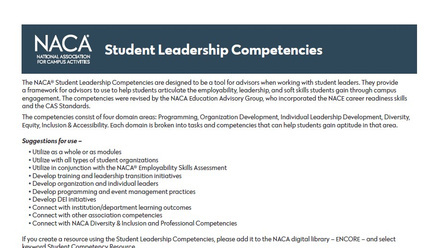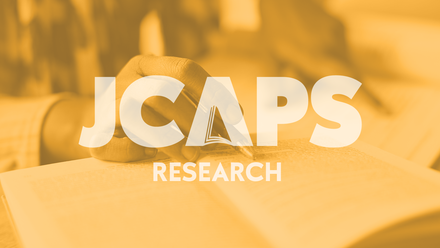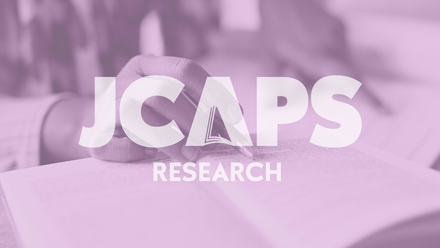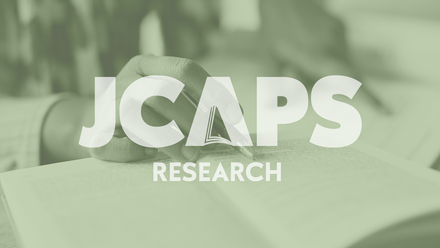Professional Competencies Workbook
The NACA competencies are organized by domains of application (Organization Development & Advising, Program & Event Management, Human Resource Management, and Campus Culture & Community Building) and have additional tags depicting learning level (knowledge, comprehension, application, and analysis). These learning levels mirror those in the NACA® Competencies for Diversity and Inclusion.
This online workbook provides considerations (what do you need to ask or think about), examples for use (what are some ways you can put the competency into practice), and suggested resources for each competency.
Campus activities professionals engage deeply in supporting and advising a wide range of student organizations, ensuring students learn and implement strategies for effective organization management. Additionally, campus activities professionals apply principles of organization development in their own departments, organizations, and institutions. Campus activities professionals should be able to both effectively teach as well as personally demonstrate mastery of the competencies in this domain.
Relationship Development Competency Tasks
- Understand team/group dynamics and use strategies for building effective teams within an organization. (Comprehension/Application)
- Develop and maintain mutually-beneficial partnerships between organizations. (Application)
Relationship Development Considerations
-
Team building models and theories
-
Personal identity development
-
Individual inter-team and intra-team relationships
-
Who is on campus (student orgs, offices, departments, etc.) and who are beneficial partners?
Relationship Development Examples for Use
-
Dedicate time in training in naming the different group dynamic stages for group reflection
-
Dedicate time in training to know who is on campus, their roles, and functions
-
Use of team building exercises during trainings
-
Use of inventories and personal development tools and how individual styles work together
-
Connect with potential partners/stakeholders
-
Visit their meetings
-
Set up individual conversations
-
Invite them to your meeting
-
-
Include relationship maintenance in transition training
Relationship Development Suggested Resources
Harper, K. (2020). The heart of a leader: 52 emotional intelligence insights to advance your career. Rowan & Littlefield.
Have a great resource you'd like to recommend? Let us know at [email protected].
Training Competency Tasks
- Design and implement effective training events and resources for student organization leaders (Application)
- Design and Implement effective training events and resources for student organization advisors (Application)
Training Considerations
-
Mission and vision of the institution and organization
-
Intended outcomes of the training
-
Different levels of knowledge of organization leaders/advisors
-
Modality of the training - learning styles, variety of information presentations
-
Timing of the training - logistics, just-in-time, meeting them where they’re at
-
Types of advising models used when advising student organizations - who is the audience? What are we asking them to do and how does that tie in with their current responsibilities?
Training Examples for Use
-
Design and implement a training conference for incoming club and organization executive board members. Use the mission to guide learning outcomes.
-
Ask the students who were participating their preferred way of watching/receiving information. Record the live presentation and upload to YouTube so that it can be viewed later.
Training Suggested Resources
Have a great resource you'd like to recommend? Let us know at [email protected].
Fiscal Management Competency Tasks
- Identify organization priorities and prepare budget proposal(s) in alignment with said priorities. (Knowledge/Application)
- Be knowledgeable of institutional fiscal policies and procedures (as well as variations in policies/procedures relative to funding sources) and ensure department spending is in alignment said policies and procedures. (Knowledge/Application)
- Manage and ensure accuracy of organization income and expense reports. (Application)
- Grow and maintain personal integrity as a steward of organization’s financial resources; make ethical and prudent decisions about the use of organization’s resources. (Analysis/Application)
- Seek external sources of funding, such as soliciting corporate sponsorships and cultivating financial gifts to the organization. (Application)
Fiscal Management Considerations
-
Identify different levels of fiscal knowledge on the team; is more training needed?
-
Understand contracts, riders, and contract negotiations.
-
Understand institution policies for budgeting and requesting and spending funding.
-
What are the policies on soliciting external funding and donations? Is there a department that manages external partnerships and grants?
-
Understand how different budgets are funded.
-
Who are the experts on campus who can help with training or explaining policies and procedures?
Fiscal Management Examples for Use
-
Use the tasks in this domain in annual staff training.
-
Set priorities, review relevant institutional policies, brainstorm external sources of funding, etc.
-
Use assessment data to inform budget requests.
-
Develop a process for reallocation of funds as priorities and opportunities shift.
-
Determine internal or personal approach for tracking allocated funding.
Fiscal Management Suggested Resources
Barr, M.J., & McClellan, G.S. (2018). Budgets and Financial Management in Higher Education. 3rd Edition. Jossey-Bass.
Have a great resource you'd like to recommend? Let us know at [email protected].
Marketing and Branding Competency Tasks
- Generate marketing strategies that effectively communicate information and relevant stories to target audiences (Application)
- Identify appropriate social media platforms for various marketing efforts (Comprehension)
- Analyze effectiveness of marketing strategies and make appropriate adjustments in future efforts to improve message reach (Analysis)
Marketing and Branding Considerations
- What areas can students and student organizations be trained in and what areas need to be handled by professional staff?
- What systems are already in place to utilize for marketing (such as electronic screens, emails lists, etc.)?
- What policies and procedures are in place regarding department and institution marketing practices?
- Are there branding guidelines you need to follow?
- Be mindful of guidelines regarding accessibility and compliance in print and digital materials.
- Be sure to include questions about outreach on surveys/evaluations.
Marketing and Branding Examples for Use
- Create a communications plan that outlines marketing strategies.
- Conduct trainings with ADA and compliance officers on accessible marketing practices.
- Develop a shared folder that contains guidelines and files for university preferred or required trademarks and fonts.
- Create a process for multiple reviewers of graphics and documents.
- Pull analytics from posts, websites, and other campaigns to inform practices moving forward
Marketing and Branding Suggested Resources
Have a great resource you'd like to recommend? Let us know at [email protected].
Experiential Leadership Learning Competency Tasks
- Understand and employ methods for effectively coaching and/or mentoring students. (Knowledge/Application)
- Facilitate student reflection to advance student learning and development through campus involvement. (Application)
- Provide appropriate advice and support to students that also promotes student autonomy and decision-making. (Application)
Experiential Leadership Learning Considerations
- Gauge prior knowledge and skill level for students coming into leadership roles.
- Determine who provides leadership mentoring and coaching on your campus - is it done by advisors, the activities office, SGA?
- Trainings and reflection should be done in a consistent manner, not just one touch point to start the academic year.
- How much funding could be available to your department that would be dedicated to student leadership learning (retreats, trainings, inventories)?
Experiential Leadership Learning Examples for Use
- Utilizing career resources/offices to teach students how to put involvement onto their resumes.
- Club and organization trainings, retreats, professional coaching opportunities.
- Team builders that aid in the exploration of autonomy and decision making.
Experiential Leadership Learning Suggested Resources
Have a great resource you'd like to recommend? Let us know at [email protected].
Strategic Planning Competency Tasks
- Formulate organization mission, vision and values (Analysis)
- Set individual and organization goals, and employ long-term planning strategies (Application)
- Establish effective and reliable operating procedures (Application)
Strategic Planning Considerations
- Create or regularly revisit/revise mission, vision and values; be sure organization mission, vision and values align with institutional mission, vision and values.
- Outline tasks that need to be accomplished to meet goals and long-term plans.
- Include key stakeholders (student, staff, key partners, etc.) in creation of and communication about mission, vision and values.
- How do position descriptions tie into strategic priorities?
Strategic Planning Examples for Use
- Identify a set of peer/aspirational organizations and groups to compare and contrast against.
- Regularly revisit policies and procedures to ensure they align with current practices.
- Use the plan to set budget and priorities, especially financial priorities.
- Complete a mapping exercise to see how programs and initiatives align (or not) with departmental, divisional, and organizational goals.
- Incorporate discussion of short term and long term goals and plans as a part of every retreat and planning session.
Strategic Planning Suggested Resources
Have a great resource you'd like to recommend? Let us know at [email protected].
Recruitment and Retention Competency Tasks
- Develop marketing strategies to promote involvement opportunities. (Comprehension)
- Generate strategies for identifying and successfully recruiting new organization members. (Application)
- Evaluate organization success in retaining members and devise strategies to ensure members are appropriately involved in organization operations. (Analysis/Application)
Recruitment and Retention Considerations
- Whose responsibility within the organization focuses on recruitment and retention initiatives?
- Does the organization have a defined plan for recruitment of new members and the retention of existing members?
- Are members welcome to join at all times of year?
- In what spaces and through what modalities are membership opportunities promoted?
- What strategies are used to make membership accessible to all student populations? Be mindful of how your organization does or does not reflect the student body.
- Are positions within organizations well defined and are there position descriptions available?
Recruitment and Retention Examples for Use
- Offer programs that explain what involvement in and/or leadership of orgs looks like.
- Create easy to access and follow Standard Operating Procedures.
- Develop recruitment and outreach strategies towards student organizations of various identities.
- Share outcomes and benefits of membership as part of your marketing strategies.
- Survey students regarding why or why not they are involved in student organizations.
Recruitment and Retention Suggested Resources
Have a great resource you'd like to recommend? Let us know at [email protected].
Campus activities professionals oversee a vast array of ongoing programs and individual events. Many various skills are required to effectively manage both continuing programs and distinct events, including administrative, relationship-building, and student development.
Policy Knowledge, Development, and Management Competency Tasks
- Develop, implement, and enforce policies for managing student groups, in alignment with institutional and external policies and laws (Application)
- Implement policies equitably, with consistency and reasonable accommodations when appropriate (Comprehension/Application)
- Review and benchmark policies, particularly with a culturally competent lens (Analysis)
Policy Knowledge, Development, and Management Considerations
- Understand how your policies map on to local, state, and federal policies
- Acknowledge the differences between policies, guidelines, and recommendations
- Ensure student groups have access to policies and the avenues to provide feedback
- Know who on campus is the “owner” of policies and how frequently they are reviewed.
- Institute cyclical review timelines for departmental policies.
- Look to similar departments/institutions for examples when writing new policies.
- If accommodations are made, document them in writing, including justification
Policy Knowledge, Development, and Management Examples for Use
- Create a policy adoption timeline which dictates the vetting and approval process for new policies
- Conduct review of policies to check for implicit biases or targeting language towards certain populations
- Post new policies in student emails and communications sharing their ability to offer feedback
- Partner with high presence student organizations and departments to create avenues for discussion and dialogue
- Communication plan for student organizations, university departments, and community organizations that share how they policy implementation or change impacts them
- Engage in conversations with peer and aspirational institutions about their policies and the reasons they came to exist
Policy Knowledge, Development, and Management Resources
Have a great resource you'd like to recommend? Let us know at [email protected].
Assessment and Data Management Competency Tasks
- Assess both operational and learning outcomes (Application)
Use data effectively to make data-based decisions and manage change (Analysis) - Manage data collection processes (Comprehension)
- Grow and maintain personal integrity as a steward of data; Make ethical and prudent decisions about the use of data (Analysis/Application)
- Employ technology to manage data (Comprehension)
Assessment and Data Management Considerations
- Review or research the basics of assessment, including methodology, analysis, and reporting.
- What are your outcomes? Create outcomes if none exist.
- What data, data sets, and assessments currently exist? Who the "experts' are and when and how to consult them in assessing data, and creating assessments.
- What technology (E.G. software) exists to gather, analyze, report, and store assessment data?
- Is the information that you are collecting going to be used? (E.G. Don’t collect demographic information unless it is necessary.) What information will be produced and shared as a result of the assessment?
- Plan out how assessments map onto university or departmental goals and initiatives - asks questions that matter and collect data that you will and can use
- Be intentional with the timing of assessments and where they fall in the cadence of the academic year as well as the frequency of assessments.
- How are data stored and secured and is confidential information protected? Is there an institutional policy related to securing data?
- Are there other assessment-related policies, such as those pertaining to Institutional Review Board (IRB) approval, that need to be followed?
Assessment and Data Management Examples for Use
- Create departmental learning outcomes and strategic plan that aligns with institutional mission, goals, and strategic plan.
- Collaborate with your institutional research office or other offices on your campus that collect data.
- Create a regular cadence of assessment (for example, 1-2 departmental goals each year) to make the process more manageable.
Assessment and Data Management Suggested Resources
- Search Assessment 101 in the NACA Resource Library for a series of assessment webinars
- Kerr, K.G., Edwards, K.E., Tweedy, J., Lichterman, H.L., & Knerr, A.R. (2020). The Curricular Approach to Student Affairs. Stylus.
Have a great resource you'd like to recommend? Let us know at [email protected].
Technology Competency Tasks
- Selecting and utilizing appropriate technology to assist with tasks (Comprehension)
- Developing familiarity with common technologies and their relation to campus activities (Knowledge)
- Build partnerships with Information Technology staff to accomplish goals (Comprehension)
Technology Considerations
- “Technology” may cover a breadth of areas, such as physical space, software, cloud based services, equipment, etc.
- Understand what technology is available and what functions it contributes to
- When purchasing technology, conduct a needs assessment, involve all stakeholders, be aware of budget limitations
- Comprehend university policies and practices that dictate how technology and services can interface with University systems
- Regarding inclusion, consider how technology may create or break down barriers
- Define the task, or challenge that you want to utilize technology to address.
- Consider other institutional stakeholders to increase efficiencies and communication through a technology solution.
Technology Examples for Use
- Conduct routine meetings with IT staff about needs and information request and how processes can be made more efficient and effective.
- Connect with NACA associates and members about what services they offer or how they are using technology on campus.
- Participate in design and renovation conversations with folks who manage common spaces for events on how technology can be updated or added.
- Use platforms to track attendance and compare with retention numbers of specific populations.
- Adding people counters above doorways of the student activities center to track usage and high volume times.
Technology Suggested Resources
Have a great resource you'd like to recommend? Let us know at [email protected].
Legal Issues and Risk Management Competency Tasks
- Understand and utilize protocols outlined by institution (Knowledge)
- Identify and mitigate risk in programs and events (Application)
- Read, amend, and process contracts and other legal documents in accordance with institutional policies and procedures (Comprehension)
- Understand relevant federal, state, and local laws and their impact on campus activities (Comprehension)
Legal Issues and Risk Management Considerations
- The differences and similarities between state and federal legislation on the impact of events and opportunities. Also, the nuances of public and private institutions.
- Who needs to be invited to the table to discuss the details of the event and is there an opportunity to strategically add partners in at different times?
- Timelines and authorization authorities change constantly, so what are your standard touch bases with partners and stakeholders?
- There are three types of risk to be aware of: physical risk (bodily harm), reputational risk (perception by others), and institutional risk (violation of policy or procedure).
- Know who the experts are on campus and their processes for submitting, requesting, and distributing information.
- What is your role as an institutional agent and how is it described in policy, job description and executed in practice?
Legal Issues and Risk Management Examples for Use
- Quarterly check-ins with legal affairs, risk and emergency management, and procurement/contractings.
- Annual advisor training regarding policy and practice regarding common state and federal policies.
- Setting up Google Alerts for key terms that are similar or effect your program or benchmark institutions.
- Incorporation of campus resources and personnel into student training to demystify processes and procedures.
- Creation of a single document that outlines checklist and processes and links to consider in program and event planning.
Legal Issues and Risk Management Suggested Resources
Have a great resource you'd like to recommend? Let us know at [email protected].
Crisis Management Competency Tasks
- Create emergency plans for anticipated crises across event types (Application)
- Train volunteers and staff on responding to and managing crises (Application)
- Follow venue protocols in crises (Knowledge/Comprehension)
Crisis Management Considerations
- Who are the campus partners that need to be involved in decision making and crisis management strategy conversations?
- Become familiar with building policies and procedures for situational events and understand your role in sharing information.
- Understand how to handle internal and external crises and what really constitutes a crisis.
- Regularly review and update emergency plans.
- Practice emergency preparedness via trainings and drills.
- Establish connections with local and state emergency management and first responders.
Crisis Management Examples for Use
- Pre-event video that plays before the event starts reminding guest of exits and procedures of see something - say something (think movie theater).
- Develop a communication plan that includes phone trees and on/off campus resources .
- Volunteer briefing before events sharing updates and things to be aware of that could occur during the timing of events.
- Conduct pre-event walk throughs with key stakeholders to become aware of emergency protocols and to walk through scenarios.
- Vet plans and protocols with risk and emergency management/ general counsel to mitigate potential issues.
Crisis Management Suggested Resources
Have a great resource you'd like to recommend? Let us know at [email protected].
Networking and Business Relationships Competency Tasks
- Identify key partners for programs and events, including campus partners and external vendors (Comprehension)
- Maintain a professional demeanor and act with competence, courtesy, and ethics (Application)
- Communicating effectively with partners, including exchanging information with timeliness and understanding (Comprehension)
Networking and Business Relationships Considerations
- Modality of the communication. Think about which communication method may be best for the conversation you need to have. Zoom? In Person Meeting?
- Different programs and events may require different relationships. Think about what needs the program/event may have and who needs to be around the table to make that happen. It might not always be the same group.
- Take an interest in your relationships outside of the task at hand. Good networking and relationship building happens by connecting with the person outside of the current event/program/relational need.
- Grow the network for both parties. By introducing your contact to the rest of your team/your students/etc., you are creating new opportunities for business and growth for all parties.
- What relationships already exist in your department/division that you can leverage? It is good to ask who your colleagues may already know who can assist in a program/task.
- What policies are in place at your institution around working with certain clauses? Are there non-compete clauses, or preferred vendors you need to use first?
Networking and Business Relationships Examples for Use
- Dedicate time during employee onboarding for new hires to meet key on campus partners.
- Setup calls with off-campus partners to introduce new hires to key vendors.
- Find times throughout semester to continue connections outside of meetings/projects.
- Attend professional conferences or virtual meetups.
- Utilize online resources (ex: LinkedIn, NACA Connect).
Networking and Business Relationships Resources
Have a great resource you'd like to recommend? Let us know at [email protected].
Event Support Competency Tasks
- Understand event production, including audio-visual needs, performer hospitality, atmosphere, and creation of an experience for attendees (Comprehension)
- Communicate effectively with vendors and business partners using business terminology (Comprehension)
Event Support Considerations
- Event accessibility and accommodations.
- What space, equipment, and other resources are available on campus and what costs are associated with each.
- Awareness of high-risk events and communication with the legal office, campus police, etc.
- Understanding and negotiation of contracts and riders, and laws/guidelines around contract payments.
- Knowledge of union and labor laws which impact operations and set-up.
- Who is the owner of policies surrounding events?
- Understanding the event planning budgets.
- Understand where the Freedom of Speech areas, amplified sound, and class room locations are.
- Assessment of attendees experience.
Event Support Examples for Use
- Standing meeting with event and operation staff of venues that allow for recap and preview of events.
- Development of protocols and checklist that allow for staff to have a flow for advancing and producing a show .
- Where applicable, shadow an event that you are not in charge of to better understand how event operations occur.
- Creating meetings and workshops with business partners to better understand their needs/wants when working with your functional area.
- Attending industry events/conferences to network with business partners to better understand their work.
Event Support Suggested Resources
Have a great resource you'd like to recommend? Let us know at [email protected].
Intentionality in Student Learning Competency Tasks
- Facilitate student learning through campus activities programs (Application)
- Develop outcomes and design programs and events to accomplish outcomes (Analysis)
- Guide students to articulate their learning through involvement in campus activities (Analysis)
Intentionality in Student Learning Considerations
- Learning outcomes should tie to departmental and institutional mission and vision statements.
- Learning outcomes can be written for the department and/or individual programs.
- Learning outcomes must be measurable. Use direct and indirect measures to capture learning.
- Consider not only what participants are learning, but also what is being learned by the students planning and executing the programs.
Intentionality in Student Learning Examples for Use
- Reference the Student Leader Competencies to help students articulate the skills they have learned.
- Alignment to university mission, vision, purpose, and strategic plans to show how student engagement supports university goals.
- Writing position descriptions for student leaders or student workers.
- Assessment - tell the story of learning to administration.
- Creating departmental/programming/annual goals.
Intentionality in Student Learning Suggested Resources
Kerr, K.G., Edwards, K.E., Tweedy, J., Lichterman, H.L., & Knerr, A.R. (2020). The Curricular Approach to Student Affairs. Stylus.
Campus activities professionals assume responsibility for numerous human resource functions including identifying and hiring student and professional staff as well as the recruitment and retention of volunteers. Beyond identifying volunteers and staff, campus activities professionals are responsible for training, supervision of the different constituent groups and tasked with developing the individuals they supervise. Additionally, campus activities professionals are charged with cultivating a productive, safe and engaging work environment or volunteer experience.
Volunteer and Staff Management Competency Tasks
- Select, onboard, and train volunteers and staff (Application/Analysis)
- Understand the differences between managing volunteers and staff (Knowledge)
- Recognize volunteers and staff (Application)
- Cultivate a healthy and productive working relationship with your supervisor and other campus leadership (Application)
- Create a culture of trust through communication, agreement, and accountability for shared expectations (Application)
Volunteer and Staff Management Considerations
- Understand the differences between managing up and down.
- Delegation of tasks based on roles and responsibilities.
- Practice transparent communication.
- Schedule intentional time for development (one-on-one meetings with supervisor/supervisee).
- Motivations of volunteer staff - why did they agree to be a part of this project/team/event.
- Consider how information is shared so folks don’t feel excluded from processes, but understand the need for tiered information sharing.
- Various methods of recognition (in-person, email, public/private).
- Ensuring there is a diverse set of viewpoints and backgrounds of selection committees, and chosen volunteers and staff.
Volunteer and Staff Management Examples for Use
- Creating of tiered committee or levels of responsibility charts.
- Writing position descriptions to show the full scope of responsibility and the impact of work being done.
- evaluating compensation, promotion, and recognition programs based of skill and production level.
- Creating 360 feedback opportunities so that all within the organization are able to contribute to development and growth.
- Balance of one on one vs full team meetings so that individual and group issues can be addressed in different settings.
Volunteer and Staff Management Suggested Resources
- Consult your human resources office for on-boarding/staff hiring processes.
Have a great resource you'd like to recommend? Let us know at [email protected].
Supervising Competency Tasks
- Align with laws and institutional human resource policies (Knowledge/Application)
- Manage job creation, including writing job descriptions, advocating for resources, and managing workspace (Application/Analysis)
- Evaluate performance, including promotion and termination (Knowledge/Analysis/Application)
- Manage different types of supervisees: professional staff, administrative staff, graduate students, and undergraduate students (Analysis/Application)
Supervising Considerations
- Be aware of federal, state, local, and institutional policies that may govern your work.
- What institutional, organizational, or professional association resources exist to support the development of supervisory skills?
- What institutional processes exist for performance review? Do you need to implement an annual or biannual (twice a year) process?
- Be aware of your own supervision style and how it may influence your behavior.
- Understand the challenges, needs, opportunities that exist within various levels of the organizational chart.
Supervising Examples for Use
- Utilize assessments, such as Clifton Strengths, to understand how to more effectively work with your team.
- Conduct regular one-on-one meetings and provide performance feedback regularly (don’t just wait for the annual review).
- Regularly review job descriptions to evaluate job descriptions, resources, and space allocation are congruent with the actions, tasks and responsibilities of the position.
- Conduct an yearly staff retreat to review departmental mission and goals and work to align with professional development goals of staff members.
Supervising Suggested Resources
Manual of Me - A Manual of Me is a powerful framework which helps you discover and communicate your working preferences, motivations and needs, so we can all work better together.
Have a great resource you'd like to recommend? Let us know at [email protected].
Professional Development Competency Tasks
- Advocate for personal and professional development opportunities including involvement with professional associations and community (Application)
- Cultivate self-efficacy and create opportunities for mastery capacity to succeed in multiple settings, and in relationship with others (Analysis)
- Encourage self-care and work-life integration (Application)
Professional Development Considerations
- Understand where professional development funding may be available and how to access it.
- If funding isn’t available, consider other ways to learn and develop (such as book clubs, article shares, etc.).
- Consider how volunteering may help gain wanted/needed skills in areas outside of typical job duties.
- Searching for professional development grants available through various associations and outlets.
- Model work-life balance behaviors.
- Evaluate times that you need to be available for work, and times you can block out during a work day.
- Advocate to take on passion projects related to your role.
Professional Development Examples for Use
- Creation of professional development line in annual budgets to centralize importance.
- Incorporate into annual evaluation for staff for recognition and growth opportunities.
- Tie access to professional development funds to department/divisional/institutional awards.
- Include access to professional development funds and opportunities in job postings and positions descriptions.
- Connect staff to community/campus organizations that allows for additional skills to be developed.
- Creation of mentoring community circles that allow for lived experiences to be shared among participants.
- Consider tiered opportunities; attending v presenting; certificates v certifications; credentials v continuing education opportunities.
Professional Development Suggested Resources
- Various professional association volunteer opportunities (ex: NACA)
Have a great resource you'd like to recommend? Let us know at [email protected].
Campus activities professionals are vital to the recruitment and retention of students. In order to create and cultivate affinity with the institution, campus activities professionals need to understand, work within, and when applicable, challenge and preserve institutional culture, expectations and traditions. This will require the professional to be able to navigate campus politics and assist students in doing the same.
Institutional Culture and Expectations Competency Tasks
- Understand institutional culture (Knowledge)
- Explain institutional culture to internal and external constituents (Comprehension/Application)
- Explain institutional expectations for programs and services to internal constituents (Comprehension/Application)
- Affect change within campus culture (Application)
- Continually review and adapt programs and services to meet institutional expectations and culture (Analysis/Comprehension/Application)
Institutional Culture and Expectations Considerations
- How does the institution represent itself through mission, vision, values, marketing?
- Review available data on campus demographics.
- Connect with folks within your department and other departments to help deepen understanding of culture.
- Connect with community members and key stakeholders.
- What do students think of the culture? Does anecdotal evidence align with the data gathered?
- Do some aspects of the culture need to be challenged or dismantled? What are some ways to approach change?
- Do your assessment practices address cultural aspects?
Institutional Culture and Expectations Examples for Use
- Review University strategic plan.
- Understand the trends in university enrollment and demographic trends.
- Pull University annual reports and/or annual surveys used to assess student, faculty, and staff culture.
- Identify university peer and aspirational institutions so that benchmarking and growth conversations can occur.
Institutional Culture and Expectations Considerations Suggested Resources
Have a great resource you'd like to recommend? Let us know at [email protected].
Institutional History Comptency Tasks
- Know relevant institutional history including broader institutional history and focused office/programs/services history (Knowledge/Comprehension)
- Work with campus archives to research programs and services (Analysis)
- Organize and preserve records for the future in various formats, both within the office and through campus archives (Application)
- Understand history and role of office/program/service within campus traditions (Knowledge/Comprehension)
- Support, celebrate, affect change with campus traditions (Application)
Institutional History Considerations
- How are records maintained, stored, and organized? Are records accessible beyond one person’s computer? Are there legal obligations or institutional policies regarding record retention?
- Is there a campus archive? Should one be established by the appropriate campus department?
- What information is relayed in annual reports?
- How is the institutional history relevant to campus traditions, campus culture, institutional mission, and current trends? What pieces of campus history instill pride of and connectivity to the institution? Are there shameful pieces of campus history that need to be acknowledged and used as a means of learning and growth?
- Are campus traditions still relevant? Should they be updated or sunset?
Institutional History Examples for Use
- Review past annual reports.
- Take a tour with campus ambassadors/admissions to learn more about the campus.
- Google the institution to see what news stories pop up.
- Meet with community partners and neighborhood associations to understand their perception of the university and its workings.
Institutional History Suggested Resources
Have a great resource you'd like to recommend? Let us know at [email protected].
Campus Politics Competency Tasks
- Understand one’s own scope of decision-making authority (Knowledge)
- Understand chain of command at institution and how to navigate institution as both a staff member and student (Knowledge/Comprehension)
- Identify campus influencers and utilize them to support, celebrate, and affect change with campus culture, traditions, and expectations (Analysis/Application)
- Cultivate relationships with administration, faculty, staff, and alumni (Application)
Campus Politics Considerations
- Who needs to be involved in decision making around cultural, tradition, and policy changes?
- What decisions can be made on your own and what decisions warrant conversations with others before a decision is made?
- What committees can you serve on that influence campus politics and can affect change?
- How are you sharing your story to build relationships and grow your sphere of influence?
- Build upon your knowledge of campus culture and institutional history to understand campus politics.
Campus Politics Examples for Use
- Connect regularly with people outside of your department.
- When new to a role, call predecessor to get insights into how to navigate office, departmental, and university personalities.
- Show up and support offices and events that are hosted by offices of influence so rapport can be built.
- Create opportunities to invite stakeholders to the table to share insights and perspectives.
- Create a list of key contacts across campus.
Campus Politics Suggested Resources
Have a great resource you'd like to recommend? Let us know at [email protected].
Cultivating a Sense of Belonging Competency Tasks
- Provide and promote a wide range of involvement opportunities (Application)
- Build community on campus through programs and services (Application)
- Assess needs of students from multiple perspectives, identities and populations and ensure campus involvement opportunities are relevant and inclusive (Analysis)
- Cultivate relationships with students (Application)
- Create and promote a sense of connection to the institution (Application)
- Utilize NACA Competencies for Diversity and Inclusion, as well as other resources, to develop, provide, and advocate for programs and services that cultivate a sense of belonging for all students (Application)
Cultivating a Sense of Belonging Considerations
- Mission and vision of the institution and organization.
- Who are your students? Which populations are you focusing on? Which need more attention?
- NACA defines sense of belonging as the extent to which individuals feel their authentic self is personally accepted, respected, included,supported, and safe in the university environment. How does your definition of sense of belonging differ?
- How and when are you assessing student needs?
- Is there institutional buy-in for creating sense of belonging? How can we get that buy-in?
- How can we illustrate the impact of sense of belonging on retention and persistence?
- How do we create connections with students from differing identities?
Cultivating a Sense of Belonging Examples for Use
- Assess who is and isn’t attending events and engaged in beyond the classroom activities.
- Facilitate the creation of student organizations or spaces for specific identities.
- Create events that bring together the entire campus community.
- Create events that consider student identities such as parents, commuters, and working students.
Cultivating a Sense of Belonging Suggested Resources
- NACA Definitions of Involvement, Engagement, and Sense of Belonging
- Cohen, G.L. (2022). Belonging: The Science of Creating Connection and Bridging Divides. Norton.
- Perry, R. (2022). Imagine Belonging. Publish Your Purpose.
Have a great resource you'd like to recommend? Let us know at [email protected].












